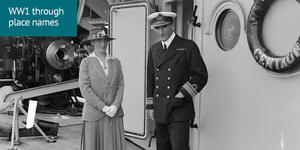
The Royal Navy on the Home Front, 1914-1918. Commodore Reginald Yorke Tyrwhitt and Lady Tyrwhitt onboard the Royal Navy's light cruiser HMS Centaur.
Mou Waho Island (Harwich) Scenic Reserve, Lake Wanaka
In 1924, Sir Frederick Chapman, a former Supreme Court judge and member of the Honorary Geographic Board of New Zealand, suggested new names for two features on Lake Wanaka. He proposed that the body of water on ‘Pigeon Island’ should become Arethusa Pool and that the Island’s highest point should be titled Tyrwhitt Peak. When the time came to seek official approval for these changes, the Governor-General, Admiral John Jellicoe, further moved that ‘Pigeon Island’ be renamed ‘Harwich Island’.
The Royal Navy’s Harwich Force was established at the outbreak of the First World War. Placed under the command of Commodore Reginald Tyrwhitt, it had three main objectives: to protect the approaches to the English Channel; to monitor German activities in the North Sea; and to escort ships between Britain and the Netherlands.
Each of these tasks was carried out successfully. Although it was absent from the largest naval engagement of the War at Jutland, Harwich Force played an important role at the Battles of Heligoland Blight, Texel, and Dogger Bank. It also captured or sank 24 enemy merchant vessels, and escorted 520 eastbound and 511 westbound ships between British and Dutch ports.
Despite being Gazetted in 1924, ‘Harwich Island’ did not achieve common acceptance. In both 1972 and 1988, the New Zealand Geographic Board (NZGB) received numerous submissions asking for a return to the original ‘Pigeon Island’. Mindful of the legislative requirement to favour Māori names, and keen to avoid confusion with Pigeon Island on Lake Wakatipu, the NZGB put forward ‘Manuka Island’ as an alternative. However, it was forced to drop this idea after fresh objections were raised.
The deadlock was finally broken by the discovery of additional evidence. Documents from the 1920s revealed that the name ‘Pigeon Island’ had actually been pre-dated by Mou Waho, or ‘outer island’. As this title offered both a new beginning and a link to the area’s Māori past, Mou Waho (for the island feature) was approved by the NZGB in 1988.
The NZGB did retain a connection to the First World War with the Island’s scenic reserve. In 2011, that area was officially titled Mou Waho Island (Harwich) Scenic Reserve.
References:
- Evening Post, 14 November 1924, p. 2.
- Heathcote, Tony, The British Admirals of the Fleet, 1734-1995: A Biographical Dictionary, Barnsley: Leo Cooper, 2002.
- New Zealand Geographic Board: Correspondence, vol. 59, pp. 169-226.
- New Zealand Geographic Board: Minutes, 2011 (81).
- Reed, A.W., Place Names of New Zealand, Rosedale: Penguin, 2010.